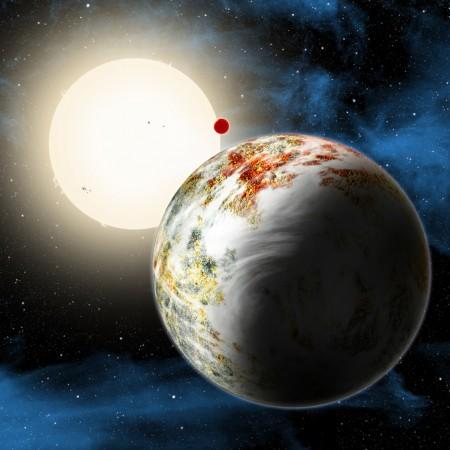
Astronomers have discovered a new type of rocky and gigantic planet, which has a hard surface like that of our planet, and is around 560 light-years away from Earth. They are currently calling the alien object "Mega Earth".
Known as Kepler-10c, the exoplanet has a mass 17 times as much as the Earth, and is rocky and also heavier than "super-Earths" – a class of planets slightly heavier than Earth.
"This is the Godzilla of Earths! But unlike the movie monster, Kepler-10c has positive implications for life," CfA's Dimitar Sasselov, director of the Harvard Origins of Life Initiative, said of Kepler-10c in a press release.
The newly discovered alien planet and its properties have been presented at the 224th American Astronomical Society meeting.
"We were very surprised when we realized what we had found," said astronomer Xavier Dumusque of the Harvard-Smithsonian Center for Astrophysics (CfA), the lead in the study in a NASA news release. They used data originally collected by NASA's Kepler space telescope.
The kepler telescope, however, is not able to detect if the new alien planet is gaseous or rocky. Initially the size of the new planet indicated that it was under "mini-Neptune" category that has think layer of gas covering the entire planet.
Dumusque and his team used HARPS-North instrument on the Telescopio Nazionale Galileo in the Canary Islands in order to measure the mass of Kepler-10c. Through the telescope, they found that the planet is actually rocky and not a gaseous Neptune-like planet.
The mega-Earth orbits around its parent star every 45 days. Kepler-10c is so close to its star that sustaining of any life forms is unimaginable.
"Kepler-10c didn't lose its atmosphere over time. It's massive enough to have held onto one if it ever had it. It must have formed the way we see it now," Dumusque explained.
Scientists, however, never thought such new planet could even exist. Planets of Kepler-10c size were thought to be gaseous that accelerate huge gravitational pull thereby turning itself into gaseous planets like Jupiter or Neptune.
The early universe comprised of hydrogen and helium gases. Heavier elements like silicon and iron, required to make rocky planets, had to be created during the early generation of stars. Explosion of those stars scattered the important ingredients in the space, which helped in the formation of Earth and later generations of stars. The entire process of the universe should have taken many billions of years. However, Kepler-10c shows that the universe was capable of forming such huge rocks even when heavy elements were limited. Scientists believe that the new alien planet was formed after the Big Bang less than 3 billion years ago.
"Finding Kepler-10c tells us that rocky planets could form much earlier than we thought. And if you can make rocks, you can make life," Sasselov said.
The new findings suggest that there could be wide range of stars that may support Earth-like rocky planets and that it broadens the hunt for extra terrestrial life.

















